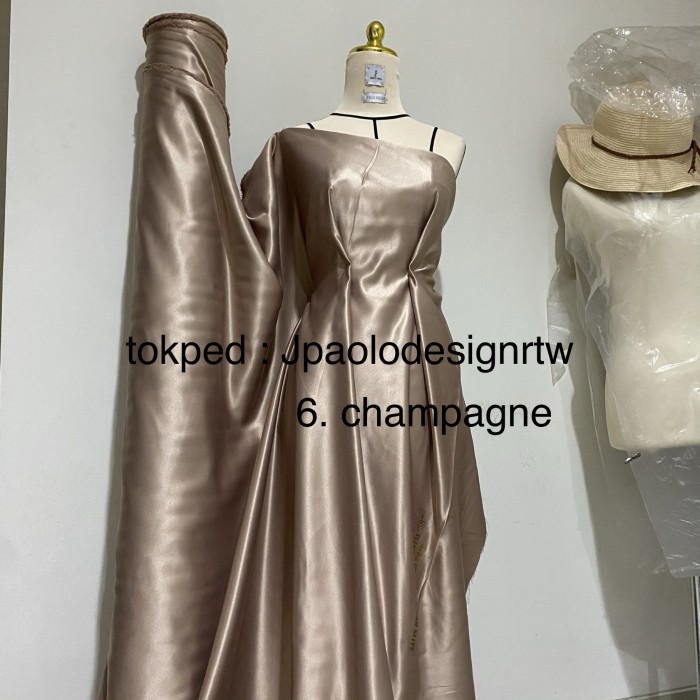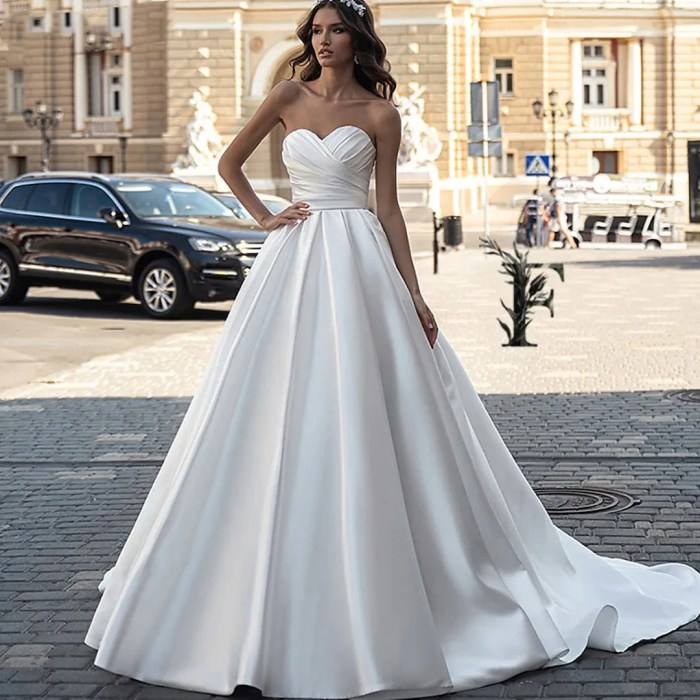Satin Strapless Ball Gown Wedding Dress
Design Elements of a Satin Strapless Ball Gown Wedding Dress
The timeless elegance of a satin strapless ball gown wedding dress stems from a careful interplay of design elements. The choice of satin, neckline, silhouette, and train length significantly impacts the overall aesthetic. Understanding these elements allows for a truly personalized and breathtaking bridal look.
Satin Fabric Selection
The sheen, drape, and weight of the satin fabric are crucial considerations. Different satin types offer varying levels of luxury and suitability for a wedding gown.
| Satin Type | Sheen | Drape | Weight |
|---|---|---|---|
| Charmeuse Satin | High luster, smooth surface | Fluid, luxurious drape | Lightweight to medium |
| Duchesse Satin | High luster, crisp surface | Structured, less fluid drape | Medium to heavy |
| Silk Satin | Subtle luster, soft surface | Soft, luxurious drape | Lightweight to medium |
| Mikado Satin | Subtle sheen, firm surface | Strong hold, less drape | Heavy |
Neckline Variations
While strapless, various neckline modifications can enhance the dress’s appeal. These variations offer diverse levels of coverage and visual impact.
- Sweetheart Neckline: A classic choice, featuring a curved neckline that mirrors the shape of a heart, flattering the bust and creating a romantic look.
- Straight Across Neckline: A modern and minimalist option, providing a clean, geometric line across the shoulders and emphasizing the décolletage.
- Modified Sweetheart: A less pronounced curve than a traditional sweetheart, offering a subtle yet flattering neckline.
- Slightly Plunging Neckline: Adds a touch of boldness, subtly revealing the cleavage while remaining elegant.
Ball Gown Silhouettes, Satin strapless ball gown wedding dress

Source: tokopedia.net
The silhouette defines the skirt’s fullness and waistline placement, creating distinct styles.
- A-Line: A classic and flattering silhouette, flowing gently from the shoulders to the floor, creating a graceful and timeless look.
- Ball Gown: A full, voluminous skirt that creates a dramatic and princess-like effect. The waistline is typically defined at the natural waist.
- Empire Waist: The waistline sits just below the bust, creating a flowing skirt that skims the body, offering a romantic and ethereal look.
- Fit-and-Flare: A fitted bodice that flares out into a full skirt, offering a balance of structure and movement.
Train Lengths
The train length significantly impacts the overall visual effect of the gown, adding drama and elegance.
- Chapel Train: Extends several feet behind the wearer, reaching approximately to the mid-calf.
- Court Train: A longer train that extends several feet, sweeping the floor majestically.
- Cathedral Train: The longest train, extending several yards behind the wearer, creating a dramatic and regal effect.
- Sweep Train: A shorter train that sweeps the floor but does not extend significantly behind the wearer.
Fabric and Construction Considerations

Source: etsystatic.com
Constructing a satin strapless ball gown requires precision and attention to detail. The fabric’s properties and construction techniques significantly influence the final garment’s quality and drape.
Construction Process
The construction involves meticulous seam allowances and techniques. Typical steps include pattern making, cutting the satin fabric (allowing extra for seam allowances and potential adjustments), assembling the bodice (often with boning or corsetry for structure), constructing the skirt (with careful attention to gathering and layering for volume), and finally, attaching the skirt to the bodice and adding the train.
Boning and Corsetry
Boning provides structure and support to the bodice, while corsetry offers a more defined and sculpted shape. Boning is often incorporated into the seams of the bodice, while corsetry provides a structured underlayer that shapes the torso.
Challenges with Satin
Satin’s smooth surface can be prone to slippage and seams can be challenging. Using appropriate seam finishes (such as French seams or Hong Kong seams) and interfacing are essential to prevent slippage and maintain clean seams. Careful pressing is also crucial to maintain the fabric’s drape and prevent distortion.
Creating a Seamless Finish
Achieving a smooth, seamless finish involves meticulous stitching, pressing, and careful attention to detail. Seams should be invisible, and any gathers or pleats should be evenly distributed to create a polished and professional look. The use of lining can also help create a smooth, even surface.
Styling and Accessories
Styling a satin strapless ball gown involves thoughtful consideration of hairstyles, jewelry, and veils, all working together to create a cohesive and polished look.
Styling Options
- Classic Elegance: A sleek updo, delicate diamond earrings, a cathedral-length veil, and elegant heels.
- Romantic Bohemian: Loose waves, floral crown, minimal jewelry, and ankle-strap heels.
- Modern Minimalist: A low bun or sleek ponytail, statement earrings, no veil, and simple, pointed-toe heels.
Wedding Footwear
The choice of footwear should complement the gown’s silhouette and the overall wedding theme. Options range from elegant heels to comfortable flats, depending on personal preference and practicality.
Accessorizing for Different Themes
Accessories can be tailored to reflect the wedding theme. For example, a rustic wedding might incorporate natural elements like flowers and wood, while a modern wedding could feature geometric jewelry and clean lines. A classic wedding would emphasize timeless elegance and refined details.
A satin strapless ball gown is a stunning choice for a wedding ceremony, offering elegance and drama. However, for the post-wedding reception, you might prefer something more comfortable and less formal; consider a more relaxed style like those showcased on this helpful site for post wedding reception dresses. Returning to the wedding dress itself, the satin fabric and strapless design are undeniably glamorous, making it a memorable choice for your special day.
Impact of Undergarments
Undergarments play a significant role in shaping the silhouette and ensuring a smooth fit. A well-fitting bra and shapewear can create a seamless and flattering look, while the wrong undergarments can create unwanted lumps or bumps.
Visual Representation and Descriptions
Visualizing the dress allows for a better understanding of its design and impact. The fabric’s drape, embellishments, and overall aesthetic all contribute to the final look.
Ivory Satin Ball Gown
Imagine an ivory satin strapless ball gown with a sweetheart neckline, featuring a flawlessly draped bodice that accentuates the bust and a flowing, cathedral-length train that gracefully pools on the floor. The satin’s luxurious sheen catches the light, creating a shimmering effect. The overall impression is one of timeless elegance and sophistication.
Embellishments
Lace appliqués can add delicate texture and romance, beading provides shimmering accents, and embroidery allows for intricate detailing. These embellishments can be strategically placed to highlight certain areas of the dress, such as the neckline or waistline, creating focal points and enhancing the overall design.
Drape and Flow of Satin
The satin fabric’s drape and flow are key elements. The skirt should cascade gracefully, creating a sense of movement and fluidity. The fabric should move effortlessly, creating soft folds and ripples that enhance the gown’s elegance.
Matte vs. High-Gloss Satin
Matte satin offers a subtler sheen, creating a more understated and elegant look. High-gloss satin, on the other hand, offers a more dramatic and luxurious effect, reflecting light brilliantly.
Market Trends and Inspirations
Current fashion trends and the work of prominent designers influence the evolution of ball gown designs.
Prominent Designers
- Vera Wang: Known for her dramatic silhouettes and intricate detailing.
- Monique Lhuillier: Celebrated for her romantic and ethereal designs.
- Oscar de la Renta: Renowned for his classic and sophisticated style.
Current Fashion Trends
Current trends often incorporate elements such as puffed sleeves, asymmetrical designs, and unconventional necklines into ball gown designs, creating a modern twist on a classic style.
Color Options
Beyond ivory, popular satin wedding dress colors include blush pink, champagne, light blue, and soft gray, reflecting a broader palette of preferences.
Embellishments Reflecting Trends
Embellishments reflect current trends. For example, the use of 3D floral appliqués reflects a current trend towards romantic and textured details, while minimalist beading speaks to a preference for clean and understated elegance.
FAQ Explained
How do I choose the right satin for my wedding dress?
Consider the sheen, drape, and weight of the satin. Heavier satins are more structured, while lighter satins offer more flow. Consult with a seamstress to determine the best option for your body type and desired silhouette.
How do I prevent my satin dress from wrinkling?
Proper storage is key. Hang your dress in a garment bag in a cool, dry place. Avoid packing it tightly or exposing it to direct sunlight or heat. Steaming can help remove minor wrinkles.
What kind of undergarments should I wear with a strapless ball gown?
Consider a strapless bra or a body shaper designed for smooth lines under the gown. Avoid anything that might show through the fabric or create unwanted bumps or lines.
How do I clean my satin wedding dress?
Dry cleaning is highly recommended for satin wedding dresses to prevent damage and maintain its quality. Always use a reputable dry cleaner specializing in wedding gown preservation.



















